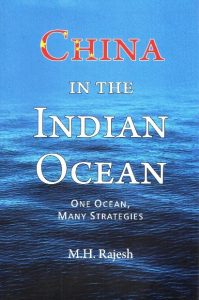
About the book
“China in the Indian Ocean – One Ocean, Many Strategies” by M.H. Rajesh is a book that focuses on China’s rise and related events in the Indo-Pacific. The book addresses the economic and strategic aspects of China’s presence in the Indian Ocean using the grand strategy of Belt and Road Initiative as a broad parameter that connect the dots through multiple regional events. The book mainly describes the various parameters into which China has developed its interests in the Indian Ocean Region. These various parameters are divided into 10 chapters including the introduction and the conclusion chapters.
Chapter 2 – The book opens up with the historical and cultural interpretations on China abound in Chinese strategic concepts like ‘middle kingdom’ or the ‘mandate to rule all under heaven’. However, it is the ‘China Dream’ that defines the development in the present that is to achieve for China’s political and economic growth. And one of the determinants that aim to deliver this dream is the project ‘Belt and Road Initiative’ (BRI). As the book is mainly focused on the ocean, the author has generally dissected the project to describe the continental plan for which the Maritime Silk Road can be understood. It describes the Martin Stopford’s idea of West Line depicting the maritime shift which remains significant for growth in global economy and political stability in international relations and China, like any other state is influenced by Indian Ocean’s vast geographical space that it looks to dominate economically, politically and militarily through its project of BRI.
Chapter 3 – The third chapter is about the Maritime Military Strategy of China and how it evolved over time keeping in mind the changing security dynamics of IOR. This chapter describes the major motivating factors that encourages China’s evolving naval strategy in the region, along with paying attention to the increase in naval capabilities to channelize its military power to assert political and economic gain in the region.
Chapter 4 – The chapter indicates the Chinese geopolitical and maritime behaviour in South China Sea (SCS) and describes the importance of the SCS in gaining strategic stronghold in Indian Ocean. The SCS is considered to be the maritime backyard of Chinese coastline where the effect of Chinese political and military growth is felt for the first time. The chapter gives a brief description on various arbitrations awarded on the territorial disputes of SCS, basing the rules created under the UNCLOS and follows it with the Chinese and international response on these interventions. The 2013 case in The Permanent Court of Arbitration at The Hague, forwarded by Philippines remains to be the only landmark judgement on the SCS dispute where China chose to ignore the arbitral verdict.
Chapter 5 – This chapter focuses on the strategic space of Indian Ocean that China wishes to assert its influence in and also to keep a check on deep geographical vulnerabilities for itself in the region. It discusses the diversity among Indian Ocean littorals and the major layers of security structure in the IOR that protects from various security issues the region faces. This chapter focuses on the Chinese dependence on the region, particularly the investments, trade, energy and arms sales along with securing its assets from the vulnerabilities that it faces over the course of time while pushing its larger goal of regional influence.
Chapter 6 – The sixth chapter is a case study for China’s engagement with Pakistan, its strongest ally in the region. The chapter revolves on the main theme of China Pakistan Economic Corridor (CPEC) and the change in perspective for China’s Pakistan policy focused exclusively on deterring against India, while expanding to a broader alliance where an economic weft is laid over a strategic warp deepening the existing relationship. The redevelopment of Gwadar Port into a rejuvenating maritime terminus will provide both China and Pakistan with its respective goal in the region. The author has provided descriptive information on the various dimensions of the CPEC project including the infrastructure development connecting the Southern Baluchistan Province of Pakistan and the Xinjiang Province of China through the extension of rail and road projects, development of the energy sector which is the primary for its transportation of goods through the land route.
Chapter 7 – In the next chapter, the author addresses China’s move towards other potential footholds in the IOR including countries like Sri Lanka, Maldives and Bangladesh. He argues that even if these footholds are neither large enough for attractive markets nor are connected geographically with China, these countries are potential Indian Ocean hubs for China in times of crisis that will provide access to their ports and prospective bases and can also be developed into military bases when needed. China has developed its commercial maritime network all over the IOR, from where it can manage its commercial trade both from land and maritime routes.
Chapter 8 – China doesn’t have direct access to the Indian Ocean Region as it doesn’t share any maritime boundary with the ocean. Thus, the chapter focuses on the five countries that can play an important role in influencing China’s entry into the Indian Ocean. China’s primary focus has always been to open new corridors for trade to negate its dilemma of Malacca Strait and for that it has extended its cooperation through infrastructure development in Myanmar which can open the gateway of road, pipeline and waterways transport corridor to China’s Kunming region. The author addresses that the countries like Thailand, Singapore, Malaysia and Indonesia plays an important role for China’s Indian Ocean strategy. But the closeness that these countries share with US further dilutes the hopes of China’s strategic influence in these countries though it shares a strong relationship.
Chapter 9 – This chapter is about China’s quest for resources which influences its IOR strategy. The two key important sub-region that looms large with respect to China’s quest for resources are Middle East and Africa. The island nation of Mauritius and Seychelles are also discussed in the same chapter as both these countries play an important role in the transit routes to Africa. Also, the chapter talks on Australia and its periphery that the author analyses as having vibrant trade and investment opportunities for China, but politically both are opposite to each other as the latter is a liberal democracy.
Chapter 10 – The last chapter is the conclusion chapter where the author analyses China’s IOR strategy through the prism of contemporary global issues that will characterise its policy towards the region. The author has further analysed the various catalyst like the BRI Project, import of natural resources, the search for alternate access routes, and its various footholds as important for China’s IOR strategy.
Analysis
The author in this book has done a very informative study on China’s quest towards having a strong IOR strategy. The China strategy pivots on the access to energy, resources and markets available in the Indian Ocean. In the quest for access to these resources China has been focusing on the political, economic and infrastructure gaps that the small nations in the IOR faces and bridge those gaps through economic and political support to influence the countries foreign policy in its favour. But the author has not much addressed the factors like debt-crisis and encirclement of India’s maritime boundary by creating footholds in the IOR, which can play an important role in managing the security ecosystem of the region. The book has also described the various challenges that China faces in its policy towards the region and what it has been doing to mitigate these challenges.
Recommendations-
The book is easy to read and contains information of all the factors that influences China’s Indian Ocean strategy. The book is a must read for research scholars who want to pursue research in the particular field. It will also be useful for the policymakers of India who can get idea for future policies regarding the Indian Ocean Region. The book is written from the point of view of military personnel and thus will be useful to read for defence strategists for getting a broad idea on China’s interests across the spectrum in IOR.
Conclusion
The concluding chapter ends with an interesting note that there is no ‘single’ Indian Ocean Maritime Strategy of China. It is in fact a series of sub-strategies at work, each tailored to address China’s needs, the domestic politics of nations, and the regional politics of Indian Ocean. Thus, China influence can mitigate its own challenges for the region, but will create tensions across the IOR as China through its revisionist policies and will try to overshadow the other regional states like India. Thus, the author suggests that a timely trickle on occasions serves more than a torrent.













